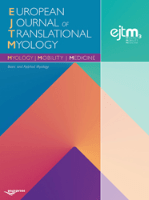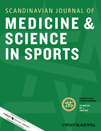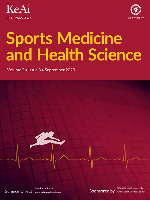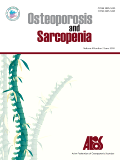
European Journal of Translational Myology
Scope & Guideline
Bridging Experimental Research with Clinical Applications
Introduction
Aims and Scopes
- Muscle Biology and Physiology:
Research exploring the fundamental biology of muscle tissues, including cellular mechanisms, muscle architecture, and the molecular pathways involved in muscle function and regeneration. - Rehabilitation and Therapeutic Interventions:
Studies evaluating various rehabilitation strategies, therapeutic interventions, and exercise programs aimed at improving muscle function and recovery in various patient populations. - Sarcopenia and Ageing:
Investigation into sarcopenia, its underlying mechanisms, and its effects on the elderly, along with strategies for prevention and management. - Neuromuscular Disorders:
Research on the pathophysiology, diagnosis, and treatment of neuromuscular disorders, including muscular dystrophies and other related conditions. - Innovative Diagnostic and Treatment Techniques:
Development and assessment of novel diagnostic modalities and treatment approaches, including imaging techniques, biomaterials, and pharmacological interventions. - Interdisciplinary Approaches:
Involvement of various disciplines, including physical therapy, nutrition, and exercise science, to provide comprehensive insights into muscle health and rehabilitation.
Trending and Emerging
- Telehealth and Remote Rehabilitation:
There is an increasing interest in telehealth solutions for rehabilitation, particularly in the context of the COVID-19 pandemic, reflecting a shift towards remote patient management and virtual care. - Exercise and Nutrition Integration:
An emerging focus on the intersection of exercise and nutrition, particularly how dietary interventions can complement physical rehabilitation to enhance muscle recovery and health. - Advanced Imaging Techniques:
Growing utilization of advanced imaging modalities, such as 3D-CT and ultrasound, to assess muscle condition and guide rehabilitation strategies, indicating a trend towards more precise diagnostic methods. - Proteomic and Molecular Research:
A rising trend in proteomic studies aimed at understanding muscle pathology and regeneration at the molecular level, indicating a deeper exploration of the underlying biological mechanisms. - Mental Health and Rehabilitation:
An increasing recognition of the importance of mental health in rehabilitation outcomes, with more studies addressing psychological factors in muscle recovery and exercise adherence.
Declining or Waning
- Traditional Pharmacological Interventions:
There is a noticeable decline in studies focusing on traditional pharmacological approaches to muscle disorders, as research shifts towards more innovative and integrative treatment strategies. - Generalized Exercise Programs:
Research on generalized exercise programs without specific tailoring or individualized approaches is less frequent, indicating a move towards more personalized rehabilitation strategies. - Basic Biochemical Studies:
The focus on fundamental biochemical studies of muscle tissues appears to be waning, with a growing emphasis on translational research that connects laboratory findings to clinical applications.
Similar Journals

Current Opinion in Physiology
Advancing Insights in the Dynamic World of PhysiologyCurrent Opinion in Physiology, published by Elsevier, is a leading journal dedicated to the dynamic field of physiology. With an E-ISSN of 2468-8673, this journal provides a platform for the latest insights and perspectives, reflecting the evolving landscape of physiological research. Operating from the United Kingdom, the journal holds a respectable impact factor and is ranked Q2 in both general physiology and medical physiology categories, highlighting its prominence among the global academic community. With Scopus rankings placing it in the 64th and 60th percentiles within its respective categories, Current Opinion in Physiology serves as an essential resource for researchers, professionals, and students eager to stay informed about innovative theories and emerging trends in physiology. The publication emphasizes high-quality reviews that summarize current knowledge and future directions, ensuring readers gain valuable insights applicable in both clinical and research settings.

EXPERIMENTAL PHYSIOLOGY
Shaping the future of Nutrition and Physiology research.EXPERIMENTAL PHYSIOLOGY, published by WILEY, stands as a vital resource in the fields of Nutrition and Dietetics and Physiology, providing high-quality, peer-reviewed research since its inception in 1990. With an impressive categorization into the Q2 quartile in these domains, the journal emphasizes the integration of experimental and clinical findings, making significant contributions to our understanding of physiological processes and nutritional impacts on health. The journal operates within a competitive landscape, ranked significantly in Scopus, showcasing its relevance to both the medical community and nutritional sciences, as evidenced by its rankings in Nursing, Medicine, and Biochemistry. Though it is not currently open access, the journal remains an indispensable tool for researchers, professionals, and students seeking to deepen their knowledge and stay updated on cutting-edge research. With a publication window extending to 2024, EXPERIMENTAL PHYSIOLOGY continues to influence the academic discourse and promote advancements in its respective fields.

JOURNAL OF ELECTROMYOGRAPHY AND KINESIOLOGY
Advancing the Science of Movement and MuscleThe Journal of Electromyography and Kinesiology, published by Elsevier, is a distinguished academic platform that focuses on the intricate interrelations between electromyography, kinetic analysis, and their applications in health and sports sciences. Established in 1991, this journal has maintained a rigorous publication standard and continues to be pivotal in advancing knowledge in biophysics, neurology, and sports science, with impressive Q1 and Q2 ratings in multiple categories as of 2023. With an impact factor that underscores its significance in the scientific community, the journal contributes to a deeper understanding of muscle function and movement patterns, making it an essential resource for researchers, healthcare professionals, and students alike. While it operates under a subscription model, the insights provided by the journal are invaluable for anyone invested in the fields of biomechanics, rehabilitation, and neuromuscular research. For over three decades, this journal has become a cornerstone for disseminating groundbreaking research and fostering collaboration among scholars in the ever-evolving landscape of kinesiology and electromyography.

SCANDINAVIAN JOURNAL OF MEDICINE & SCIENCE IN SPORTS
Leading the Way in Sports Medicine Excellence.SCANDINAVIAN JOURNAL OF MEDICINE & SCIENCE IN SPORTS, published by Wiley, stands at the forefront of research in the fields of orthopedics, sports medicine, and physical therapy. Established in 1991, this prestigious journal has built a strong reputation, reflected in its Q1 ranking across multiple categories including Orthopedics and Sports Medicine, and Physical Therapy and Rehabilitation, as of 2023. With a discerning focus on innovative research and practical applications, the journal publishes high-quality studies that advance the understanding of sports performance and rehabilitation strategies. Although it does not offer open access, it remains accessible through various institutional subscriptions, ensuring that both practitioners and academics can benefit from its findings. The journal's commitment to excellence is further evidenced by its impressive Scopus rankings, placing it in the top 94th percentile within its respective fields. As the athletic landscape continues to evolve, SCANDINAVIAN JOURNAL OF MEDICINE & SCIENCE IN SPORTS serves as an essential resource for researchers, clinicians, and students dedicated to improving health outcomes in sports and exercise.

Journal of Nutrition Health & Aging
Empowering healthier aging with innovative research.Welcome to the Journal of Nutrition Health & Aging, a prestigious publication dedicated to advancing knowledge in the critical fields of nutrition, gerontology, and geriatrics. Published by Elsevier Science Inc, this journal boasts an impressive impact factor and is recognized in the top quartile (Q1) of multiple categories including Geriatrics and Gerontology, Medicine (miscellaneous), and Nutrition and Dietetics. Since its inception in 1997, it has served as a vital platform for researchers, practitioners, and students alike to disseminate innovative research and practical applications relevant to aging populations. With a Scopus rank placing it in the top 15% of its field, it underscores its commitment to high-quality and impactful scholarship. Although it is not an open access journal, its significant reach ensures that valuable insights will continue to inform best practices and policy decisions in health and nutrition. We invite you to explore and contribute to this vital conversation surrounding health and well-being in older adults.

Sports Medicine and Health Science
Innovating the Future of Sports Health and TherapySports Medicine and Health Science, published by KEAI PUBLISHING LTD, stands as a pivotal resource for scholars and practitioners in the dynamic fields of sports medicine and health sciences. Established as an open access journal in 2019, it provides a platform for rigorous research that fosters innovation and improvement in physical therapy, rehabilitation, and orthopedics. With an impressive range of quartile rankings, it is recognized as a Q1 journal in Physical Therapy, Sports Therapy and Rehabilitation, and Q1 in Rehabilitation as of 2023, highlighting its esteemed contribution to the academic community. The journal is also notable for its high Scopus rankings, including a rank of #19 in Medicine Rehabilitation, situating it within the top percentile of research in these areas. Based in Beijing, China, the journal's scope encompasses a wide array of topics, ensuring comprehensive coverage of advancements and emerging trends. With its commitment to open access and high-quality content, Sports Medicine and Health Science is an essential publication for researchers, healthcare professionals, and students seeking to enhance their knowledge and contribute to the field.

JOURNAL OF VASCULAR RESEARCH
Exploring the frontiers of cardiovascular science.Welcome to the JOURNAL OF VASCULAR RESEARCH, a reputable academic journal published by KARGER that has been a cornerstone of vascular research since 1964. With an ISSN of 1018-1172 and an E-ISSN of 1423-0135, this journal plays a vital role in disseminating cutting-edge research in the fields of Cardiology and Cardiovascular Medicine and Physiology. Currently categorized in the Q3 quartile for both disciplines, it ranks as #179 in Cardiology and #131 in Physiology according to Scopus, showcasing its significant contribution to the scientific community. Although the journal operates on a subscription basis, it strives to provide accessible content that informs and inspires researchers, professionals, and students alike. As the journal looks forward to its convergence in 2024, it continues to uphold its mission of advancing knowledge, fostering innovation, and encouraging collaboration within the dynamic realm of vascular research.

JOURNAL OF MUSCULOSKELETAL & NEURONAL INTERACTIONS
Innovating Research for a Healthier FutureJOURNAL OF MUSCULOSKELETAL & NEURONAL INTERACTIONS, published by JMNI in Greece, serves as a vital platform for disseminating cutting-edge research in the fields of musculoskeletal and neuronal sciences. Established in 2002, this journal has continued to evolve, presenting studies that bridge the critical interactions between musculoskeletal health and neuronal function. With a current impact factor reflected in its rankings, it holds a Q3 classification in Endocrinology, Diabetes and Metabolism, and a Q2 classification in Orthopedics and Sports Medicine, alongside Q3 in Physiology, placing it prominently within the academic landscape. The journal's accessibility, while not officially labeled as Open Access, ensures that valuable research findings are available to an international audience of researchers, professionals, and students committed to advancing the understanding of human health. The depth and breadth of content in the JOURNAL OF MUSCULOSKELETAL & NEURONAL INTERACTIONS underscore its importance in fostering innovation and collaboration across related disciplines, making it a must-read for those invested in the future of musculoskeletal and neuronal research.

MLTJ-Muscles Ligaments and Tendons Journal
Connecting Clinicians and Researchers for Enhanced CareMLTJ-Muscles Ligaments and Tendons Journal, published by EDRA SPA, is an influential peer-reviewed journal dedicated to advancing knowledge in the fields of orthopedics and sports medicine. With a strong focus on the biomechanics, pathology, and treatment of musculoskeletal disorders, MLTJ serves as a vital resource for researchers, clinicians, and students alike. The journal is indexed in Scopus and has achieved a respectable Q3 quartile ranking in its category for 2023, positioning it among the competitive publications in the field. Although the journal utilizes an open access model, it remains committed to the dissemination of high-quality research, thus facilitating a broader impact on practice and education. With converged publication years spanning from 2011 to 2024, MLTJ continues to build its reputation as a critical platform for innovative studies and clinical advancements, contributing significantly to the understanding and treatment of musculoskeletal health.

Osteoporosis and Sarcopenia
Unveiling insights into aging and mobility.Osteoporosis and Sarcopenia is a leading journal dedicated to the multidisciplinary exploration of diseases related to bone health and muscle degeneration, published by Elsevier. With an ISSN of 2405-5255 and an E-ISSN of 2405-5263, this open-access journal has been a vital resource since its inception in 2015, enabling unrestricted access to groundbreaking research. Its objective is to elucidate the interplay between osteoporosis and sarcopenia, offering valuable insights into diagnostics, treatment strategies, and preventive measures in the field. The journal serves as a crucial platform for researchers, healthcare professionals, and students, fostering collaboration and innovation in understanding these prevalent conditions. Given the global rise in aging populations, the significance of this journal cannot be overstated, making it an essential reference for those committed to advancing knowledge in musculoskeletal health.